Mar 30, 2015 | Baltimore, BEP, books, coins, commemorative, Red Book, tokens, US Mint
 As it does three times per year, Whitman rolls into the Baltimore Convention Center for the Whitman Baltimore Expo. This time, rather than the showing being in Halls A and B it was held in E and F. The new location within the building was not as intuitive to find as walking to the end and Whitman did not do as good of a job as they could have in placing their signs. But for general access, which is was off of South Sharp Street, it provided a little better access than off of West Pratt Street, which is a main artery as it passes in front of the Inner Harbor.
As it does three times per year, Whitman rolls into the Baltimore Convention Center for the Whitman Baltimore Expo. This time, rather than the showing being in Halls A and B it was held in E and F. The new location within the building was not as intuitive to find as walking to the end and Whitman did not do as good of a job as they could have in placing their signs. But for general access, which is was off of South Sharp Street, it provided a little better access than off of West Pratt Street, which is a main artery as it passes in front of the Inner Harbor.
Although there were the same number of booths, the space felt smaller. Lights were brighter since these halls seem to have been converted to using LED lighting—the brighter space made the convention center seem less cavernous. Aisles were not as wide and some of the layout changed, but it seemed to have the same number of dealers. Some of the dealers who had larger spaces did downsize and the one vendor of supplies that is not Whitman did not set up at the show. It is not known if they decided not to attend or were not invited to attend. Since Whitman does not carry all books and supplies, it would be nice if they had another supplier.
On thing I have noticed is that since the death of numismatic book dealer John Burns in early 2014 there seems to be fewer numismatic book offerings at some of the east coast shows. Aside from missing his sharp wit, I was always able to find something a little off-beat or out of the ordinary amongst the books he had for sale. While there was a book dealer at this show, the items were more toward what I would consider ordinary. I hope someone steps in with some interesting items.
As I walked the floor and spoke to many of the dealers (late Friday afternoon), they all said that they were doing well. With the area still a bit chilly and no sports to take over the downtown Baltimore area (home opener for the Baltimore Orioles is on Friday, April 10), visitors to downtown Baltimore had plenty of time to visit. For those of us who like access to a major coin show, it is good to hear. If the dealers are doing well then they will keep coming back. If the dealers come back, the show goes on.
Both the U.S. Mint and Bureau of Engraving and Printing had booths at the show. While the U.S. Mint was showing current products, the Bureau of Engraving and Printing had some historical information. Although it is good to see the U.S. Mint at the show, it might be nice to see some historical artifacts. Since most of the U.S. Mint’s collection was given to the Smithsonian Institute, maybe they can be convinced to bring an exhibit to the show. Having the Smithsonian there would be very different than other shows since they have a different type of collection than the American Numismatic Association, for example.
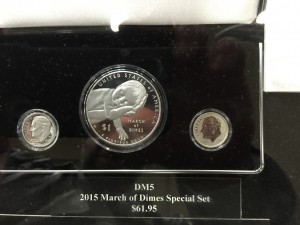
2015 March of Dimes Commemorative Proof set will cost $61.95 when released
Another interesting find was the First Edition of the Red Book Deluxe Edition. While flipping through it at the show, it looks like the Red Book on steroids. There is more information, more detail on pricing, and some other features. A first impression is that it extends the Red Book franchise a bit beyond what they called their Professional Edition. While there is a lot of information, my first impression is that I wish it was more of a cross between the Professional Edition and the Coin World Almanac. Both books have their places, but to combine the pricing and information that is updated yearly (the Coin World Almanac is updated every 10 years) would be a great resource. Hopefully, I will get my hands on one to review.
Finally, no show would be complete with out my one cool find. After walking the floor for a few hours I finally stat at the table of Cunningham Exonumia and had a nice chat with Paul Cunningham while searching for something New York. While I have not given up coins or Maryland Colonial Currency, I seem to be having more fun trying to find tokens and other exonumia from New York City and my hometown of Brooklyn. I have seen Paul at many other shows and have purchased from him. He always has a great selection. For me, I may have exhausted some of his inventory. This time, the pieces he was offering this weekend I already have in my collection.
But it did not stop me from looking. Tokens are very interesting. They are alternatives to money and are more tied to the culture of the community than money. For me, a New York Subway token not only represented a ride on the subway, but it also represents a different part of my life. It makes collecting very person. Although I have a collection of subway tokens I continue to look because you never know what you can find—especially an error.
What I found was a large token with an error. It was sold as the “Large Y” token where the “Y” was supposed to be cutout. Those tokens were used from 1970-1978 and two fare increases starting out at 30-cents in 1970, 35-cents in 1972, then 50-cents in 1975. But what I found is not that token. After examine the token carefully and some others I have, this is an error to the “Solid Brass NYC” Token. Introduced with the 60-cent fare in 1980, the “Y” was part of the raised design and not cutout. The clue as came when examine the obverse (the side that says “New York City Transit Authroity”). Between the “N” and the “C” is the tail of the “Y” but without its top. That tail would not have existed on the earlier tokens because they would have been cut out. Instead, the is a die issue where only the tail of the “Y” on one side was struck.
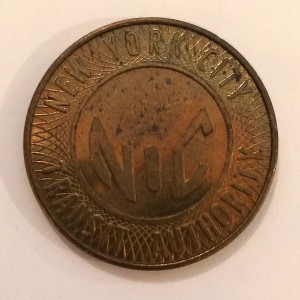
Large Brass “NYC Token” used from 1980-1985 with partial “Y” (obverse)
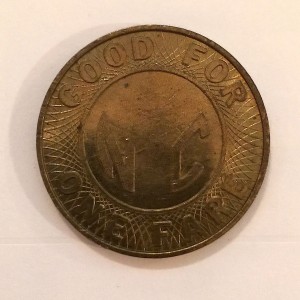
Large Brass “NYC Token” used from 1980-1985 with missing “Y” (reverse)
It might not be the error I expected, but it is an error nonetheless! It also does not make it any less fun or valuable because it will fit nicely in my collection.
If you were not able to make it Baltimore, here are some of the pictures I had taken at the show:
Sep 23, 2014 | books, coins, commentary
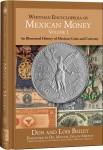 Most of the time I do not like repeating press releases or reporting on press releases. Press releases are written by or for the company issuing them. By design, they are written so that the announcement shows the company in a good light. I would rather use the product and report about it based on my own experience. But I am going to make an exception because of the long term implications.
Most of the time I do not like repeating press releases or reporting on press releases. Press releases are written by or for the company issuing them. By design, they are written so that the announcement shows the company in a good light. I would rather use the product and report about it based on my own experience. But I am going to make an exception because of the long term implications.
Whitman Publishing issued a press release to announce the release of the first volume of the Whitman Encyclopedia of Mexican Money, by Don and Lois Bailey. The first volume of a planned four-volume series starts the series with an overview and history of Mexican coinage and currency covers pre-Columbian money to the colonial era, the independence movement, revolutions, modern coinage reforms, commemorative programs, and silver, gold, and platinum bullion.
Numismatic Cataloging Systems
Krause-Mishler (KM#)
Created by: Chet Krause and Cliff Mishler Cataloging system of foreign coins, primarily used by the Krause Publications’ Standard Catalogs
PCGS
Created by: Professional Coin Grading Service PCGS maintains its own cataloging system for United States coins
Pick (P#)
Created by: Albert Pick Pick was a German notaphilist who developed a cataloging system for currency
VAM
Created by: Leroy Van Allen and George Mallis Developed by the authors in 1965 to catalog die varieties of Morgan and Peace dollars
Yeoman (Y#)
Created by: Richard S. Yeoman Original author of A Guidebook of United States Coins (The Red Book) developed a cataloging system primarily for Asian coins
Significant in the announcement is that this book introduces the cataloging of Mexican coinage with the Bailey-Whitman numbering system. The press release called this a comprehensive cataloging that is cross-referenced to “older systems.” Although I have not seen the actual book, page scans sent by Whitman as part of the press release shows that the older cataloging system being cross-referenced is the Krause-Mishler (KM) numbers used in Krause Publications’ Standard Catalog of World Coins.
Those of us who study and collect foreign coins have come to rely on KM numbers to help identify coins. The KM system has not only been unable to keep up with the proliferation of modern non-circulating legal tender coins (NCLT), especially from Canada, but is severely lacking when it comes to cataloging varieties.
Aside from omissions, the Standard Catalogs are riddled with errors that sometimes are never corrected. In the case of the Standard Catalog of World Paper Money, which is also known as the “Pick” catalog since it is organized by Albert Pick’s numbering scheme, it is so riddled with problems that Owen Linzmayer has produced his own catalog with better pictures and details called The Banknote Book. In fact, you can buy the book as a four-volume set or individual chapters representing different countries. I highly recommend Linzmayer’s books over all others. Go to banknotenews.com to learn more.
While I am not a collector of Mexican money, the sample pages provided by Whitman make the book look very compelling. It is difficult to review a book based on selected sample pages from the publisher, but it looks like something that could be used as a model for similar treatment of other countries. It would be nice to see similar books for Canadian, English, and Chinese coins.
If Whitman continues and provides comprehensive catalog information for other coins, it will be good for the industry. Between Whitman and Owen Linzmayer’s work, it should force Krause to fix their issues and provide better and more complete information to the collector. As we know, the more you know about your collection the better you enjoy collecting. This is why competition is good!
Click on any image to see the larger version.
All images courtesy of Whitman Publications.
Jan 29, 2014 | ANA, books, commentary, technology
Since learning to program computers in 1976, I have been a proponent of technology and its positive effects on the progresses we have made in many areas of our lives. This technology has progressed things we can see like the automated teller machine, quicker checkouts at the grocery stores, smartphones, tablets, and even all the gizmos in your car. If I look at the iPhone in my pocket and compared it to the Poly 88 that I first programmed or the IBM 360 that I submitted punch cards to, it would be like trying to compare a Roman Denarius to an American Silver Eagle.

For those not olde enough to remember, this is a computer punch card!
I love what technology has done to enhance many aspects of our lives. And you do not have to be a user of technology to have it affect the way you live. Computers help with inventory control to ensure store shelves are stocked; manage traffic control both in the air and on the ground; and generally make the behind-the-scenes management of a lot of things easier including maintenance on this blog.
Since my response to Dennis Tucker, Publisher of Whitman Publishing LLC, I have received a mix of private email notes about one phrase: calling physical books ‘Dead Tree Editions.” In the first two hours after the post appeared, I received more than two-dozen email notes running slightly in favor of physical books. As of Wednesday afternoon, the score was 17-15 in favor of real paper.
I do not know the demographics of those who did not volunteer the information, but based on the comments like, “I have been collecting for umpteen years…” or “I was a teenager when clad coins were just beginning…” it does not take much to get a general idea of demographics.
Of the 17 who responded that they prefer paper books over e-book, I am guessing that 12 are like me, members of the AARP demographic (50 and over).
However, contrary to what some have written, I am not a techno-snob!

Scott’s 1974 Plymouth Gold Duster. No computers in this baby!!
For more images of this car, click here.
My complaint is not with the preference but the availability of e-books that will allow me and everyone else to choose. I understand the need for choice because neither Whitman nor I will convince everyone to only read e-books.
However, if you look at the demographics of the ANA and its future, the next generation that are its future members, the so-called Generation X people, is the first generation of significant technology adapters and e-book readers. Gen X’ers are the first big wave of technology adapters who know of a connected world and have a vague memory of a world before Al Gore invented the Internet.
Right behind Generation X are the Millennials who grew up with the explosion of the Internet and probably have never read a newspaper cover-to-cover. While hobby publishers may have some time adjusting with Generation X, they will lose completely to the Millennials if they do not adapt.
Whitman is not the only publisher that needs to better examine its use of technology. Krause Publications is not much better. Where Whitman lacks in vision, Krasue lacks in execution. Rather than embrace electronic publishing that is friendly to e-readers, Krause and F+W Media, its parent, is holding onto the old-style by offering its products using Portable Document Format (PDF) rather than using formats that are friendlier to e-readers.
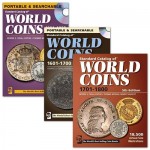
Standard Catalog of World Coins CD set covering 1601-1900
Even the venerable Numismatic News has stuck its publishing toe in the e-publishing waters by making one edition electronic. However, instead of embracing the newsstand formats that would be friendly to an iPad or Kindle e-reader, they are mailing PDF layouts of this publication. I hope you have plenty of space in your Inbox.
In the meantime, the American Numismatic Association is producing an e-reader friendly version of The Numismatist that is far easier to read than the PDF edition of Numismatic News emailed monthly. Since The Numismatist reader app works well, I stopped receiving the paper edition of The Numismatist opting for a Basic membership and to read the journal electronically. I do not miss the “Dead Tree Edition.”
 It is not a demographic issue as it is a commitment to the hobby’s future. I am sure the people at Hemming’s Motor News have a similar problem with demographics as those faced by Whitman and F+W. If you read their publications, you will notice that their demographic skews to an older population. Yet, they have quietly embraced the technologies that some of their readers want while still publishing physical magazines. I recently subscribed to the digital version of Hemming’s Classic Car on my iPad and love it!
It is not a demographic issue as it is a commitment to the hobby’s future. I am sure the people at Hemming’s Motor News have a similar problem with demographics as those faced by Whitman and F+W. If you read their publications, you will notice that their demographic skews to an older population. Yet, they have quietly embraced the technologies that some of their readers want while still publishing physical magazines. I recently subscribed to the digital version of Hemming’s Classic Car on my iPad and love it!
How could Hemming’s do this for the auto enthusiasts market but Whitman and F+W cannot do the same for numismatics?
Whitman and F+W have shown that they cannot be relied upon to be the leaders in producing the numismatic information in a way the future of the hobby will embrace. Since other markets have proven that it is possible to embrace technology to enhance the physical world, I can only emphasis my commitment to help the ANA build a better technology infrastructure because if we leave it to the market, they will fail the hobby.
Jan 28, 2014 | ANA, books, commentary, technology, web
In letter to the editor that will appear in the February 10, 2014 edition of Coin World (now available online), Dennis Tucker writes that the target of the American Numismatic Association website rebuild and acknowledging “’Young Numismatists are the future of the hobby’ are slogans to murmur approvingly, without logical reasoning.” He goes on to give his view of the market to target without recognizing facts of market forces.
For the record, Dennis Tucker is the publisher of Whitman Publishing, LLC whose books are widely read in the hobby. Whitman Expo, a division of Whitman Publishing, runs probably the three largest commercial numismatics shows in the country out of Baltimore.
Tucker, whose business is selling physical books, or what I would call “dead tree editions,” opines that it would be wiser and more productive to target those in the 50 and 60 year old demographic than 10 and 20 year olds. It is obvious that Tucker is looking at the issue from the spectrum of the business he is responsible for rather than the real future.
One problem with Tucker’s argument is similar to those in many other hobbies that rely on the collecting of physical objects: if the hobby cannot be translated to the younger demographic then the future of the hobby will be lost. As the final wave of the baby boomer generation celebrates their 50th birthday this year, empty chairs are becoming more prominent at meetings with fewer standing there to fill those chairs. There seems to be a smaller pool of people ready to join even though the population in the demographic that Tucker wants to target has grown.
Another problem with his argument is that it does not address how to reach this or any other demographic. Based on his company’s business model and his letter, Tucker is implying that even his target demographic is not using technology and cannot be reached using technology. Unfortunately, that flies in the face of researched facts.
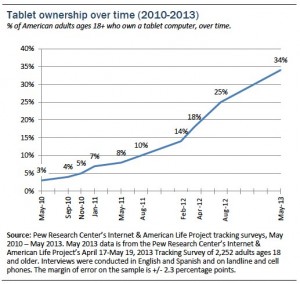
Pew Internet and Lifestyle Study: For the first time, a third of American adults own tablet computers
Using tablets as a barometer, we can look at the “Tablet Ownership 2013” report from the Pew Internet and American Life Project. In their study, Pew reports that through May 2013, tablet ownership has grown from May 2010, one month after the iPad’s introduction, the number of tablet users have increased from 3-percent to 34-percent. That is more than an 1100-percent increase in three years!
Further, Pew’s research found that the demographic with the most significant ownership are the age group of 45-54 with 38-percent ownership and 35-44 with 49-percent. The first is part of the market that Tucker wants to target while the latter is the market that should be next.
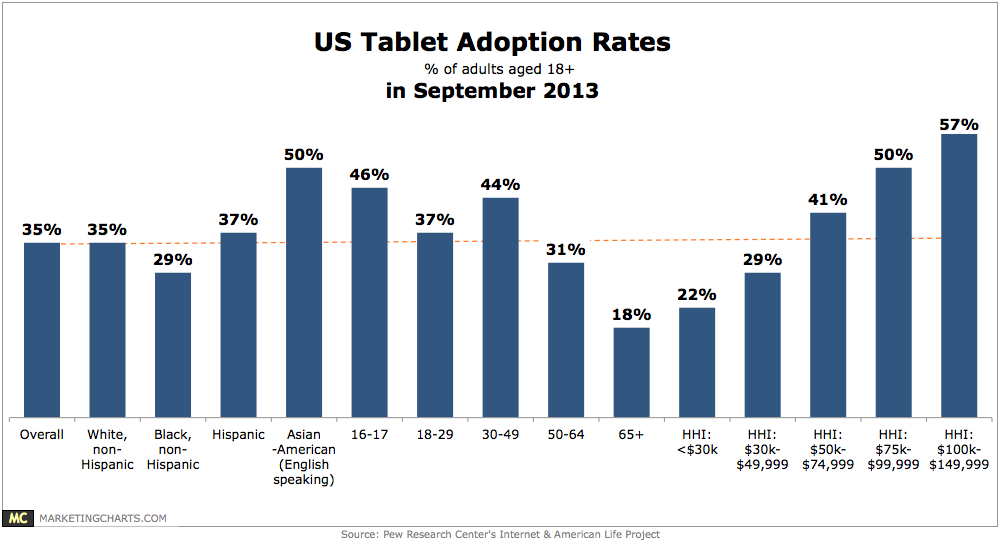
US Tablet Owner Demographics as of September 2013 (courtesy of marketcharts.com)
Pew’s research also looked at tablet ownership by income and found that 56-percent of adults that own tablets earn $75,000 or more per year. If Tucker’s goal is to target those with disposable income, just look at one of the fastest growing area of technology to understand where the markets are going.
Another study recently release by Pew notes that e-book readership has grown as the sales of e-readers have risen. While the study does not say people have not completely replaced their dead tree versions with electronic editions, there is anecdotal evidence that if more titles were available electronically, those with e-readers would take advantage of that.
In a broader look at the emerging online world, Pew Research provides trend data that shows that more people are using the technology in their daily lives. Not only are more than 60-percent of the 50-64 year old demographic using the Internet and associated technologies a large numbers, but e-reader ownership is increasing. It is also increasing in the younger demographics, including those in the 30-49 year old range who would be Tucker’s next generation of customers.
The ANA, like any business, has to adapt to new markets or they lose their relevancy. It is not enough to say to target one group over the other but you have to target the markets where they are moving. Even if the business is concentrated in one market, it has to adapt and diversify within its market or it becomes irrelevant. As a stark example, you can look at the downfall of Blackberry. Once the king of the smartphone, Blackberry, once called the Crackberry because its users were addicted to it like a crack addict was addicted to crack-cocaine, went from the most popular phone to the least popular phone because they ignored the trend set first by Apple then by Google’s Android.

Borders, a one-time success story, did not adapt to the changing market and paid for that failure.
Whitman and Tucker could help the ANA by looking at this future and target their books to this growing demographic. While the quality of Whitman’s books have improved, the companies selling tablets and e-readers are reporting increased sales of their products and an increased sales of content for those products.
Amazon is betting a lot on the tablet and e-reader market. They sell the Kindle nearly at their cost in order to lure customers into their dedicated markets. Amazon hopes to sell you a Kindle so that you buy their e-content which they make money by transferring bits. Not only has Amazon built in the infrastructure to transfer bits of information, but they are selling it as a service to others in order to reach the same markets. Amazon is betting that once you are in their market, they can sell you these bits, which are cheaper to store, package, and ship than dead tree edition books.
While the e-book market is growing, Whitman and other hobby publications are dipping their proverbial toes in this market. Although Whitman does offer a number of its books in e-reader format, they do not market that fact nor do they do any outreach in order to build that market. It is as if they publish this content so that when the topic comes up they could say that they do have e-books. They are checking the box, so to speak.

Kodachrome; You give us those nice bright colors; You give us the greens of summers; Makes you think all the world's a sunny day, oh yeah!
Growing the ANA is like growing a business; you have to look at what your target market’s demographics are and figure out how to reach them. For hobbies like numismatics, the new target is online where the current generation is moving and where the next few generations will be. Not adapting to those new markets can make both the ANA and Whitman as relevant as the Betamax and go the way of Woolworth’s or Pets.com.
I am glad the ANA is doing something to expand its market.
Trend chart courtesy of the Pew Internet and American Life Project
Data chart of the Pew Research courtesy of
marketcharts.comImage of Borders closing is courtesy of
PennLive.com.
Kodachrome box image courtesy of
Wikipedia.
Kodachrome lyrics (image caption) by Paul Simon
Sep 3, 2013 | books, cents, coins, review
Rosie was not just a riveter during World War II but she also worked at the U.S. Mint in Philadelphia making blanks for coins.
Working in the blanking room at the U.S. Mint was not an easy job. It was hot, loud, and Rosie was confused. Even though she was supposed to feed a sheet of zinc coated steel into the blanking press, Rosie fed a sheet of copper. With the press of a button, 40 copper blanks were made.
Rosie panicked. The president ordered that the U.S. Mint not use the copper for coins so it could be used for the war effort. Not knowing what to do, Rosie let the coins proceed to the next stations where they were washed and “pinched” to create rims keeping her fingers crossed that nobody found out.
The copper blanks were fed into the press along with the zinc-coated steel blanks and thus was born Penny, a 1943 copper cent.
The Wishful Penny is the story of Penny’s adventure from her accidental birth, to an ice cream shop, across the Atlantic, back again, and how one wish made on Penny comes true.
Written for readers in grades 3-5 with a story that can be appreciated by younger students, The Wishful Penny written by J.J. (Jennifer Jo) Young, co-founder of the publisher See the Wish, surrounds the story of a wish made on a penny as it is thrown into a fountain with factual information about the coin and conditions. The story opens with the book’s Rosie, a name obviously chosen, who never worked before but was thrown into working at the U.S. Mint in Philadelphia because the men were off at war. It mentions that President Roosevelt order that copper be preserved for the war effort and even approaches the angst of the time with relative off at war and businesses hoping for survival in difficult times.
The use of factual information makes the story more appealing. Forget the fact that I am some-number-of-many-years beyond the target age group for this book, it has the ability to not only teach the students but also the teachers who may have not thought about using coins as a teaching tool. If a teacher wants to use this book for classroom instruction, the authors offer a teacher’s kit that includes books, worksheets, discussion questions, activities, history tie-ins, and script with a CD of music to allow the students to perform the book as a play.
Aside from the history, the book teaches about real world perseverance from the perspective of Penny, whose optimism about carrying her wish is a good lesson for all children. While having optimism is good, the book also teaches how there is a long road to fulfilling goals that comes with the bumpy road of life. As someone who grew up with parents who wanted me to skin my knees because learning not to was as important as losing the game in order to understand life is just not handed to you, the book portrays that as a series of disappointments. With optimism in tact, Penny goes from the fountain where she meets the silver coins, to Ireland where she lives in a safe with other coins, to running away from thieves, and helping catch them before being mailed back to the United States and finding that a coin is different from the stamps that make the journey with her.
If you buy the book individually, it will come with a CD with 12 songs interspersed with acted audio scenes from the book. It is not exactly faithful to the dialog in the book, but your youngster may not mind. Remember, that the music is intended for your children and that an adult may request their child listen with headphones. After growing up with Peter, Paul and Mary, I am not sure I would have ever like the music. Since I am not the target audience I am not going to complain! However, the audio CD could be just the thing to keep your child busy for an hour during a long drive.
You can also buy the book as an audio CD. The audio book is read by January M. Akselrad, the other co-founder of See the Wish. Ms. Akselrad reads the book just like you would expect to a younger audience. However, I found myself re-reading the book along with her thinking that this might be good for a student who may have a difficult time reading to follow along while listening to the book being read for them.
Although I am not a teacher, I can see using the audio CD with the books in order to show visual highlights of story but the history it shows. Since I was not provided the teaching materials, I can only hope the authors provide teachers with this information.
Coins can teach us a lot about history and history can teach us a lot about ourselves. Although the exact reason for the existence of the copper 1943 cents can only be speculated, turning it into a story for children works on so many levels. I even like that the person who found Penny only to realize she was special was a girl learning about collecting coins. Add to that the collector who buys the coin was a woman is also a lesson that this should not be a male-dominated hobby!
I did not know what to expect when I agreed to review this book. But I was surprised how engaging it was even for a “vintage” person like me. Even though Penny ends up at less than an Mint State (MS) grade by the end of the book, I grade this book MS68 with a recommendation that if your young reader does have reading difficulties also purchase the audio CD. In fact, you may want to consider purchasing the teacher’s kit and donate it to your child’s school. Or for the classes looking to put on a play, why not consider the full-length musical with recorded music. It has to be a great idea for teachers needing new material!
POST SCRIPT FOR PARENTS: After your child reads the book and she wants more information about coins and collecting, let them vista the U.S. Mint h.i.p. pocket change website. “H.I.P.” stands for History In your Pocket, which best describes how many of us see coins.
POST SCRIPT FOR TEACHERS: After your class read this book and performs the play, I would recommend teachers visit the U.S. Mint teacher’s website for additional resources to using coins in the classroom. Who knows, maybe we can turn you and your students into numismatists!
Disclaimer
A copy of the book and audio CD was provided by the author in exchange for this review. Even as I type this, the author does not know what I will say. However, I did inform her I will be donating the audio CD to the county library to be placed in an area where the children need the most help.
Apology
I want to take this opportunity to apologize to the author for taking so long to do this review. She was prompt in sending the book and I should have made the time to reward her promptness with a timely review. I appreciate her patience.
Sep 1, 2013 | ANA, books, charity, coins, education, personal, review
 Last year I reviewed The Official 2013 Blackbook Price Guide to United States Coins I received as an e-book from the publisher. In that review I was surprised as to the quality information that was in the book including articles that were written by numismatists sharing their expertise with the collecting public. Unfortunately, some of the information seemed dated and needed updating. Apparently the editors agreed and worked to update information.
Last year I reviewed The Official 2013 Blackbook Price Guide to United States Coins I received as an e-book from the publisher. In that review I was surprised as to the quality information that was in the book including articles that were written by numismatists sharing their expertise with the collecting public. Unfortunately, some of the information seemed dated and needed updating. Apparently the editors agreed and worked to update information.
Based on the review, the editors turned to a numismatist whose experience with computers, the Internet, and writing for the collector who could add the information about using technology to enhance the collecting experience.
This is where your favorite blogger enters the picture.
The Official 2014 Blackbook Price Guide to United States Coins has an new chapter, “Using Technology to Enhance Your Collecting Experience.” Written in plain language for the collector, the chapter discusses what numismatic-related resources are online.
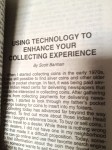 The chapter opens with a brief history of how computers and the Internet has advanced my collecting experiences. This includes a brief history of the Internet from its birth as ARPAnet through the invention of the birth of the World Wide Web and the services we now take for granted. I wrote it so that when you hear something Internet and web history in the news you have the background to understand why it is important.
The chapter opens with a brief history of how computers and the Internet has advanced my collecting experiences. This includes a brief history of the Internet from its birth as ARPAnet through the invention of the birth of the World Wide Web and the services we now take for granted. I wrote it so that when you hear something Internet and web history in the news you have the background to understand why it is important.
Following the introduction are sections that helps you find the information you want online. These sections are titled:
- Online Price Guides
- News and Blogs
- Mobile Computing
- E-books
- Social Media
- Buying and Selling Online
- Auctions (Established auction houses and their online options)
- Looking into the Future
- Your Security Online
If nothing else, the section “Your Security Online” may be worth the price of the book. It is something I have written in many forms, in many places, and have lectured about locally. These are general awareness tips that everyone should follow.
To their credit, the editors Mark Hudgeons, Tom Hudgeons Jr., and Tom Hudgeons Sr. read my review and updated the 52nd Edition of The Blackbook to address many of my concerns outside of my chapter. It is a better reference than in the past and worthy of a place in your numismatic library!
Autographs For Education
After autographing my first copy of the book I decided that rather than give away my autograph I want to use it to help raise money for numismatic education. For every autograph, I am asking for a minimum donation of $25 to the American Numismatic Association Florence Schook School of Numismatics to be used to further all numismatic education.
You can either mail the check yourself to the ANA and show me that you donated or give me the check and I will mail all of them together. Checks given to me should be made payable to the “American Numismatic Association” (NOT ME!) with a note on the memo line saying “For The Florence Schook School of Numismatics.”
For your donation, I will autograph the first page of my article above the title and give you recognition here on the blog. Since the ANA is a not-for-profit organization, your donations are tax deductible to maximum allowed by law.
One way to find out where I will be is to follow me here on the blog since I usually announce when I am going to a show. For planning purposes, I will attend the Virginia Numismatic Association Show on Saturday, September 28; the Pennsylvania Association of Numismatists show during October 24-26 (my attendance dates TBD) in Monroeville (a suburb of Pittsburgh); and the Whitman Baltimore Expo on Saturday, November 9. I might attend the Wall Street Coin, Currency and Collectibles Show in October if I can resolve a scheduling conflict.
Of course scheduling conflicts do arise, but let me know you if you will be looking for me at a show.
Post Script
Collectors of paper money, world coins, and stamps will be happy to know that the chapter will be adopted for the Blackbook covering those areas in 2015. I will also update the the current chapter since the online world has changed a little since it was written (e.g., Google shutdown the Reader service).
Book cover image courtesy of Random House.
Mar 12, 2013 | books, coins, Red Book, review, values
Merriam-Webster’s online dictionary defines almanac as “a usually annual publication containing statistical, tabular, and general information.” Almanacs have been around for a while in various forms from the earliest times of writing to today. Early almanacs were simply calendars of coming events and records of past events. They included holidays, phases of the moon, and significant dates that related to the weather for the farming community.
Although there have been many almanacs that bridged into the modern era, none had been as famous as Poor Richard’s Almanack written by Benjamin Franklin writing under the pseudonym Richard Saunders. Franklin published Poor Richard’s Alamanck from 1733-1758. Amongst the surviving almanacs include The Old Farmer’s Almanac that has been published continuously since 1792, the Farmer’s Almanac that has been published continuously since 1818, and The World Almanac and Book of Facts published since 1868. These are the almanacs that all others are judged against.
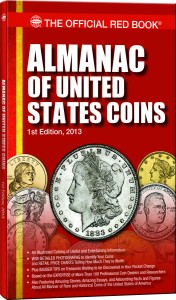 Having grown up with The World Almanac, reading the Central Intelligence Agency’s The World Fact Book, and being a begrudging fan of the Coin World Almanac, I was interested when Whitman Publishing sent out a notice that they just released the First Edition of the Almanac of United States Coins.
Having grown up with The World Almanac, reading the Central Intelligence Agency’s The World Fact Book, and being a begrudging fan of the Coin World Almanac, I was interested when Whitman Publishing sent out a notice that they just released the First Edition of the Almanac of United States Coins.
Although I read the description, I did not read it carefully because when I opened the package sent to me by Whitman, I found a skinny trade paperback-sized book. I reread the Whitman press release and it said the book was 192 pages. Initially, I felt disappointed in my hopes that there would be a competitor on the market to the Coin World Almanac since competition makes everyone better. So I can get over my initial reaction, I put the book down for a while to overcome my initial reaction to give the book a fair review.
After two weeks, I find I cannot hide my disappointment especially when I place the book next to the Coin World Almanac. Now in its eighth edition, the Coin World Almanac is 688 pages of numismatic reference that is a worthy comparison to any almanac in any industry. The problem with the Coin World Almanac is that it is updated every ten years. Having purchased the last two, the seventh edition seemed stale by 2004. I suspect the eighth edition will begin to feel stale by the end of this year if not by mid-2014. Maybe Coin World should consider shortening their update cycle.
Coin World does not have to worry about competition from Whitman. For as much as Whitman has invested in creating content across their “Official Red Book Series” from the many great authors, their Almanac of United States Coins is so lacking in content that it is many years away from being able to compete.
The only complement I can offer Whitman for this book is that many of the coin images are superb. I do like the images showing the relative grading of the individual series but wish it was expanded to include a few more grades. One example that would help collectors is that the difference between a VF-20 and MS-65 Walking Liberty half dollar is so vast, that having at least two intermediate grades (e.g., EF-40 and AU-50) would be helpful.
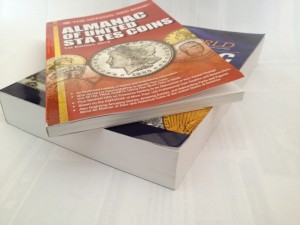
Whitman’s Almanac v. Coin World’s Almanac: In this case, size matters!
Whitman is going to have to learn that every numismatic reference book does not have to be a price guide. If they want to include type set-like guides, then do not make it look like a major component of the book. Otherwise, I would recommend people read A Guide Book of United States Type Coins instead. Thus the first improvement I would make is either eliminate the price guide information or find a way to minimize it as a central focus of each section. After all, an almanac is supposed to be about the content and the fact. Price guides are opinions that change with market forces that changes from the end of the editorial cycle until the book is published.
I know Whitman wants to sell books and has to find a way to make this book unique over their other offerings so they do not cannibalize sales, but they have to consider that they may never sell some of these books to certain people anyway. And if Whitman drops the pricing information, that still leaves their other books as an option for the reader. After all, Whitman can include a line at the end of each coin’s section that if they want in-depth information, the read can “consult” Whitman’s other book on the coin.
It is interesting how Whitman included a list of the authors for all of their books as credits but did not print the name of the editor of this book. However, Whitman’s press release named publisher Dennis Tucker as the editor.
Now that Whitman has disappointed me, they need to look at the content they have already invested in with their current books. They can start by taking whatever information is in the Red Book (A Guide Book of United States Coins), the Red Book Professional Edition, and the Blue Book (Handbook of United States Coins) and bring the content together to improve the current almanac. Just doing this would greatly improve this book. Then, it is a matter of an editor either convincing Whitman’s other authors to build on the chapters or distill the information in their other books to something suitable for an almanac.
I really wanted to like this book to the point that I put it aside in order to see if I could get over my first impression. Instead, I started to read another Whitman book that deserves the good review I will write in the near future. But I could not get over the disappointment. The text has no depth, facts that should be in an almanac are missing, and it seems like a glorified coin type price guide. Maybe they should market this as something for the very beginner, even for someone under the age of 12. Therefore I give this book a grade of F-12. The only factor that prevents this book from grading lower are the images. It is not a book I can recommend.
DISCLOSURE: Whitman Publishing provided the copy of the book I reviewed. I will not add this book to the library. It will be donated to my coin club’s annual charity auction in December with the proceeds going to the local Boys and Girls Club.
Cover image courtesy of Whitman Publishing.
Feb 21, 2013 | ANA, books, coins, museum, tokens
I am in Colorado Springs attending meetings at the American Numismatic Association Headquarters about updating the technology that is being used to support the education mission of the ANA. I will talk about my time in Colorado Springs over the weekend, but let me talk about being at the ANA Headquarters.
After walking into the reception area, to the right of the reception desk is the museum store that leads to the Rochette Money Museum. Even with the current exhibition about the history of the Civil War in numismatics, the first floor also has the first steam press used by the U.S. Mint, the McDermott/Bebee specimen 1913 Liberty Head nickel, and an 1804 silver dollar. There is also a balance from the Denver Mint.
On the other side of the main level is the Harry W. Bass, Jr. collection of gold coins and rare patterns. Bass put together the finest and most complete set of gold coins ever assembled. After Bass died, his foundation donated a portion of the collection to the ANA. I posted some of the pictures to Twitter and Pintrest and will post more when I return home, but pictures do this collection justice. You have to come here to see it for yourself.
If you are an ANA member, you should make a trip to Colorado Springs to see the Money Museum. Aside from being a benefit of your membership, the ANA has an impressive collection that is nicely displayed and worth spending the time seeing. Numismatically, there is not a display like this in the United States, especially since the Smithsonian’s National Numismatic Collection was taken off of exhibit. The ANA Money Museum is the only place you can see a real half-union pattern, typesets of every gold coin ever struck by the U.S. Mint, and even the oldest known surviving currency note.
Do you like Hobo Nickels? It’s here. Assortment of Confederate currency? They’re here, too. Examples of world currency? That’s in the lower level gallery. It is near examples of colonial currency including two Maryland notes I have in my collection.
But wait, there’s more. Do you want to learn more about what you’re looking at? On the other side of the lobby is the Dwight Manley Library. In the Manley Library you can find nearly every book ever printed on numismatics including government reports, price guides, specialty books, and books on nearly every topic of numismatics.
The library also has the oldest known illustrated coin book, dating back to the 16th century. It uses images of ancient coins to talk about the various rulers of the time. This book and the oldest book about numismatics, which does not have images, written in Latin.
Before you leave the library, stop at the old card catalog case and see the printing press that ANA founder, Dr. George F. Heath, used to print the first six editions of The Numismatist.
Yes, you can check out books from the library and have them mailed to you. Yes, you can see the traveling exhibits at various shows around the nations. But to get the full impact of what the ANA has to offer, you have to come to Colorado Springs and see for yourself.
Aside from figuring out when I can schedule a return trip, I want to know why I received three, new 2013 White Mountain quarters struck in Philadelphia when I am 70 miles away from the Denver mint.
Aug 28, 2012 | books, review, technology
There are few numismatic references as the Krause Publication’s Standard Catalog series. The multiple volume phonebook-sized references is invaluable to collectors of world coins and paper money. When it came time to update my set, I opted to buy the volumes on compact disk rather than “dead tree editions.”
Long time readers of this blog knows that I am a proponent of electronic books. E-books are the future and will dominate the publishing landscape in the next 10 years. I do not think paper will ever disappear. I believe that yearly references, such as the Standard Catalogs, will find a new, more successful home in electronic form.
I have read reviews where the Standard Catalog series has its problems with missing or inaccurate data, but it is one of the most complete references that exist. There are studies of various series that has more in depth information and a better reference for Canadian numismatics, but to have one reference for the world, there is nothing to match the Standard Catalogs. However, it would be a good idea for the staff at Krause to address the missing or erroneous information that has been communicated to them.
But this review is not necessarily on the content but the format. When you buy the CDs of the various Standard Catalogs you receive a disk with the PDF of the entire book with installation and reading instructions along with the occasional “bonus feature.” I have ignored everything on the CD except the PDF of the Standard Catalog.
Installation is easy. Insert the CD in your computer and copy the files to the hard disk. Since the files are big, the copy will take some time, but it is worth copying them to your hard drive rather than trying to use them from the slower CD. If your computer has a solid-state drive (SSD)—sometimes called a RAM or Memory Drives—I would recommend using that for storage since it is much faster than mechanical disks.
The real advantage is being able to load the file onto your mobile device and taking it with you. While you can use the files on a smartphone, the size of the file and the page formatting is best for tablets. Since I own an iPad, I was able to drag-and-drop the files into iTunes and sync the files to my iPad.
On the iPad, the Standard Catalog files were accessible using iBooks, which made navigation and searching easy. For my test in toting and using the iPad, I also sent the PDF of the Standard Catalog of World Paper Money to be opened using the Amazon Kindle app for the iPad, which requires send the file via email to a special address Amazon sets up for you once you register your Kindle app on their site. After you mail the file, then it can be downloaded to your Kindle or the app. I am not happy with the two-part process, but it does work.
There is little difference between using iBooks and the Kindle app for being able to read and search the Standard Catalog files. Searching was as easy as tapping on the screen to see the search dialog and entering what I am looking for, such as the name of a country.
While attending the World’s Fair of Money a few weeks ago, I was able to reach into my backpack to consult these references on my iPad. This was a lot easier than toting around phonebook-sized references.
The problem with using the PDF files is that the format is fixed and do not reflow to reflect the variations of the ebook formats. However, this is not Krause’s fault. Current ebook technologies, primarily the EPUB standard, does not support in-text images or the formatting of tables which is critical for the Standard Catalog references. The standards organization that is working on the next version of the EPUB specification is supposed to be addressing these issues. Until then, PDF versions are the best option.
PDF documents should be the first step on the road to ebook references. What would be better is an app that would run natively on the tablet. The app would be easier to navigate than a book possibly use imaging and pattern matching technologies to help collectors identify coins. A low cost app that may have a subset of the data with paid updates that might be available quarterly would be an option. In other words, if the costs are affordable (less than what it costs today for physical media), then it would make a worthwhile reference for all collectors.
For now, the PDF files make using the Standard Catalogs easier to use and even saves trees. I am all for saving trees especially when it is easy to use!
Aug 7, 2012 | books, coins, iPad, review, values
 Regular readers know that I am an advocate of the electronic world, especially when it comes to references that should be available in a more portable manner than paper. While dead tree editions will continue to be produced, certain references deserve to be provided in electronic form for portability.
Regular readers know that I am an advocate of the electronic world, especially when it comes to references that should be available in a more portable manner than paper. While dead tree editions will continue to be produced, certain references deserve to be provided in electronic form for portability.
In the collecting world, price guides are great to have in electronic form. You can carry them on your smart phones or tablets when you go to shows to have some idea what your potential purchase is worth. Understand that printed price guides are not the best source for prices. Prices can change daily, even hourly depending on market conditions including the costs of metals. At least the price guides will provide a general idea of the item’s value.
Price guides have more value than the prices. Some have very good and even excellent numismatic information. We know about the usual suspects in this area, but a reference to look at is The Official 2013 Blackbook Price Guide to United States Coins. The Official Blackbook is now in its 51st Edition.
I was provided an electronic review copy by the publisher with the only condition that I write this review.
Starting with the format, I cannot argue with that it is available as an e-book and complies with the full EPUB standard where the contents work, is searchable, allows bookmarks, and works well even on the iPad’s pedantic e-reader. Because e-book readers do not handle tables well, they have to be embedded as images (EPUB 3, which is still in development, should change this). However, The Official Blackbook does it in a way that makes it easy to resize them on smaller devices like the iPhone.
E-book usability issues should not be taken lightly. It is easier for publishers to publish e-books as PDF files or using other tricks that does not take advantage of the electronic formats. House of Collectibles, an imprint of Random House Reference, should be commended for doing this right.
One nice feature added by the publisher is the “Fast-Find Coin Reference Index.” This is a list of coin types, like Colonial Coins, and the name of the coin (e.g., Brasher Doubloons) that are clickable links back to the text. My only complaint is that this is the last entry in the Table of Contents and could be missed by the reader. Even though it is toward the end, I would move the entry near the top because it is that useful.
As a price guide, it is as good as any on the market with multiple price points, showing the differences between types, and mintages for each year. The tables do carry over the check box from the print edition that could be used to mark coins owned, but that is of limited usefulness in the electronic version.
After the price guides are very useful chapters about the contents of U.S. coinage. The chapters, “Primary Metals,” the silver and gold coin value charts, and the weights and measures are very good references. While other books have them interspersed within their pages, I like having this information in their own chapters.
Each section starts with a 2-3 page description on each coin type noting history, major varieties, and some design information. Where there are interesting subtleties between types, the authors provide images for the reader as a reference. Some references do this inline with the price guide, I like the idea of showing the images first and leaving the price tables as clean as possible.
At some point, the authors need to consider updating some of the numismatic writing and think about how to make it a better reference than just a series of articles. For example, the chapter “Coin Auction Sales” needs to be updated to include how most auction houses now offer Internet bidding, some are exclusively Internet bidding, and that the section’s author, Q. David Bowers, has not worked at Bowers and Merena in quite some time—I believe it was 2003 when he sold is interest in the company which since 2010 has become part of Stack’s Bowers.
The chapter “Expert Tips on Buying and Selling Coins” has some good information but needs to be updated to include buying over the Internet, using online auctions, and to separate the section on grading. In fact, the section about grading could be greatly enhanced as a standalone chapter and provide a better service to readers.
One chapter that either has to be rewritten or deleted from future books is the “Mobile Computing…” chapter. Aside from being seriously out of date with today’s online and mobile world, it is heavily slanted to support the business model of section author’s company. While it would not be bad for the author to include a blurb about their company at the end of the chapter, the entire chapter reads like one of those worthless white papers that I receive from computer vendors on a daily basis.
The two chapters that make the book worth buying is are the chapters “Erros and Varieties” and “Civil War Tokens.” Both chapters are very well written, informative, and if you do not learn something from either chapter, then you are not reading carefully. Although the author is not listed with the chapter, Mike Ellis s listed as a contributor. For those who are unfamiliar with Ellis, he is currently the CONECA Vice President and a leading expert in variety and errors. Having heard him speak in the past, having this chapter written by him is a great addition to the book and worth reading.
I also thought the chapter “Civil War Tokens” by Dale H. Cade was phenomenal. I never really thought about Civil War Tokens and their impact on commerce because of the coin shortages, but it was a fascinating read. In fact, I am re-reading this chapter because I know I missed some things while reading it for this review. I know I will now look at Civil War tokens in a different light.
There are other areas like Civil War tokens that the authors/editors of the book should consider adding as well as other impacts on U.S. coinage.
The bottom line is that after 51 years, it may be time to find a new editor to update this book and make it more reflect modern references. It has some great information, some good information, some information that is just plain useless, and there is information that could be added to enhance the book. But the great really shines while the good needs a little updating to make it great. For these reasons, I give the book a grade of MS62 with hopes that the 52nd edition will be better. I think that a proper refresh could make The Official Blackbook rival its red-colored counterpart.
 As it does three times per year, Whitman rolls into the Baltimore Convention Center for the Whitman Baltimore Expo. This time, rather than the showing being in Halls A and B it was held in E and F. The new location within the building was not as intuitive to find as walking to the end and Whitman did not do as good of a job as they could have in placing their signs. But for general access, which is was off of South Sharp Street, it provided a little better access than off of West Pratt Street, which is a main artery as it passes in front of the Inner Harbor.
As it does three times per year, Whitman rolls into the Baltimore Convention Center for the Whitman Baltimore Expo. This time, rather than the showing being in Halls A and B it was held in E and F. The new location within the building was not as intuitive to find as walking to the end and Whitman did not do as good of a job as they could have in placing their signs. But for general access, which is was off of South Sharp Street, it provided a little better access than off of West Pratt Street, which is a main artery as it passes in front of the Inner Harbor.



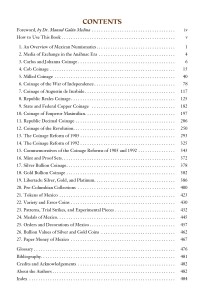
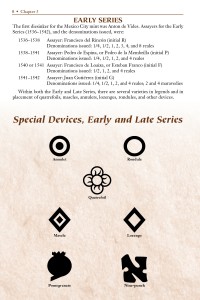
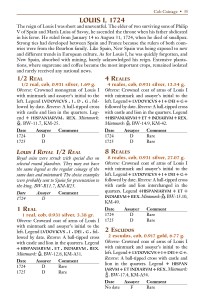





 It is not a demographic issue as it is a commitment to the hobby’s future. I am sure the people at
It is not a demographic issue as it is a commitment to the hobby’s future. I am sure the people at 





 Having grown up with
Having grown up with 
 Regular readers know that I am an advocate of the electronic world, especially when it comes to references that should be available in a more portable manner than paper. While
Regular readers know that I am an advocate of the electronic world, especially when it comes to references that should be available in a more portable manner than paper. While 